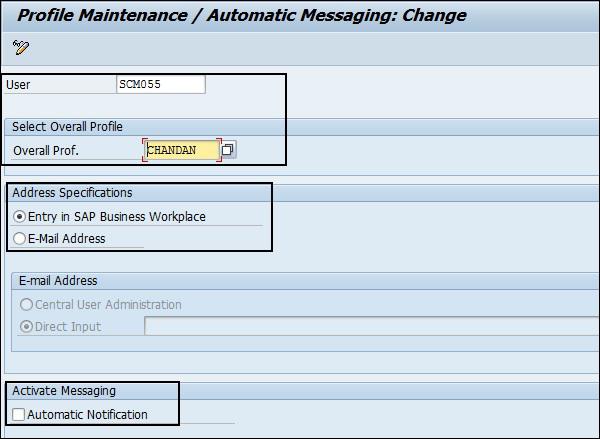SAP APO - Supply Chain Monitoring
Supply Chain Monitoring (SCM) is an effective tool to make informed decisions for the suppliers and the buyers. The key holders in supply chain process takes decisions based on Supply Chain Monitoring. Supply Chain consists of two tools −
- Stock Requirement List MD04
- Logistics Information System (LIS)
Transaction MD04/Stock Requirement List
In supply chain monitoring, all alerts raised in the system should be executed in a symmetrical way. When there are no alerts pending in the supply chain, it results in a healthy system.

Enter Material and Plant in the above screenshot and click the tick mark on top of the page.

BOM for material was exploded. Enter Purchase requisition.

Following activities can be monitored using Transaction MD04 −
- Review master data alerts
- Orders can be placed in lead time
- Shortages
- Overages
Logistics Information System (LIS)
SAP Supply Chain provides various standard reports that can be used to monitor the efficiency of the entire supply chain process. Logistics Information System (LIS) is used to mine the data for the following standard reports −
- Vendor Performance
- Sales Performance
- Maintenance Cost
- Rejection Rates
- Manufacturing Lead Time
Using LIS, you can not only evaluate actual data but you can also use it to prepare planning data.
Supply Chain Monitoring involves the following functions −
Alert Monitor
Alert monitor is used to check if your application is running fine. In an Alert monitor, you can view all the alerts and navigate directly to the application. Alert monitor can also be used with SAP Extended Warehouse Management (EWM), and Forecasting and Replenishment.
Alert monitor is used to monitor objects in the Supply Chain - material, transportation and storage constraints, capacity as well as metrics such as delivery performance, cost flow, and throughput.
Transaction Code for Alert Monitor is SAPAPO/AMON_SETTINGS or you can also open using the following path - Easy Access → Advanced Planning and Optimization → Supply Chain Monitoring → Current Settings → Set Alert Monitor.

The alert types can be managed in Transaction Code - SAPAPO/AMOCFG
To create alert application profile, click the Create button.

Select Category as Application profile, enter Profile Id, description, and application. Click the Create button in the next window.

You can display/edit alert profile, or application alert profile by navigating hierarchy under alert profile.
Sending Notifications Using Alert Monitor
Using the alert monitor, you can send alert notifications that occurred for an overall alert profile via an email or to an alert inbox. Overall alert profile in the Alert Monitor contains selection criteria for the following alerts −
To enable automatic sending of alert monitor, navigate to SAP Easy Access → Advanced Planning and Optimization → Supply Chain Monitoring →Current Settings → Set Sending of Alerts.

You need to enter the following information −
The user that you want to notify.
An overall alert profile. Note that you can only assign one overall alert profile to each system user, which is then used to notify the user.
Email address (email address or inbox in the "SAP Business Workplace").
Activate automatic notification for this system user by selecting the checkbox at the bottom of the screenshot.

You can also trigger the notifications manually. Navigate to SAP Easy Access → Advanced Planning and Optimization → Alert Monitor → Send Alerts.

Select the system user you want to notify. If you want the system to automatically send notifications at regular intervals, define a variant of report /SAPAPO/AMON_MAIL_BROADCAST

Plan Monitor
Plan monitor is used to evaluate the key figures for a plan w.r.t different objects, periods, and versions. Plan monitor can be used to compare various planning versions with each other. You can compare the planning over different periods.
The results can be displayed in the form of a table or a graphic.
Plan monitor can be called from the following applications −
Key Figure Schema
Key figure schema is used to define which "Plan Monitor" criteria are used to evaluate the planning. They are not specific to users and you can copy or delete them. The layout of the table columns and the graphical display can be changed to user-specific settings.

Under General Settings, you define the type of schema - simple display or comparison
Or Type of Display − Table, Graphic or combination of table and graphic
Under Key figures, define key figure variants −

Supply Chain Cockpit
Supply chain cockpit is a graphical tool to manage and control supply chain. It covers all the planning areas like manufacturing, demand, transportation, etc.
With the use of individual work areas, you can have several planners work simultaneously on different parts of a supply chain.

Supply Chain Cockpit allows you to −
Check the entire supply chain from all perspectives and you can drill down to the lowest level of detail.
You can remove the complexity of the relationships among supply chain components.
Flexible decision-making steps after checking the detailed level information.
You can also use it to retrieve information from SAP APO using queries.
With SCC, you can measure Key Performance Indicators of supply chain process.
Create a new work area in SCC, click the Selection icon and this will open select Work area screen.















